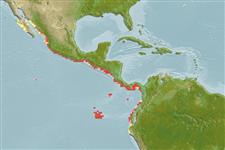Common names from other countries
Environment: milieu / climate zone / depth range / distribution range
экология
; пределы глубины 0 - 40 m (Ref. 4). Tropical, preferred 27°C (Ref. 107945); 28°N - 6°S, 115°W - 77°W (Ref. 112659)
Eastern Pacific: From Baja California Sur to the west coast of Peru and the Galapagos Islands.
Length at first maturity / Size / Вес / Возраст
Maturity: Lm ?, range 4 - ? cm Max length : 32.0 cm TL самец/пол неопределен; (Ref. 4); 30 cm TL (female)
It has lengths of 32 cm (male) and 30 cm (female), maximum total body length; 1 to 13 cm (male) and 1 to 12 cm (female), carapace length (Ref. 4). Maximum depth from Ref. 112672. Occurs at depths from 0 to 18 m and it inhabits shallow coastal waters among rocks and in cracks and crevices. The animals are nocturnal (Ref. 4). Feeds mainly on mollusks, crustaceans and organic matter (Ref. 112086).
Life cycle and mating behavior
половая зрелость | размножение | нерест | икра | Fecundity | личинки
Members of the order Decapoda are mostly gonochoric. Mating behavior: Precopulatory courtship ritual is common (through olfactory and tactile cues); usually indirect sperm transfer.
Основная ссылка
ссылки | координатор | соавторы
Holthuis, L.B. 1991. (Ref. 4)
Статус Красного Списка МСОП (Ref. 130435)
Статус СИТЕС (Ref. 108899)
Not Evaluated
Not Evaluated
Использование человеком
рыболовство: коммерческий
FAO - рыболовство: landings | FIRMS (Stock assessments) | FishSource | Sea Around Us
инструменты
дополнительная информация
ресурсы в Интернет
Estimates based on models
Preferred temperature
(Ref.
115969): 22.7 - 29.1, mean 27 (based on 170 cells).
устойчивость к внешним воздействиям
высокий, минимальное время удвоения популяции до 15 месяцев (K=0.38-0.45).
Уязвимость
Low vulnerability (22 of 100).
